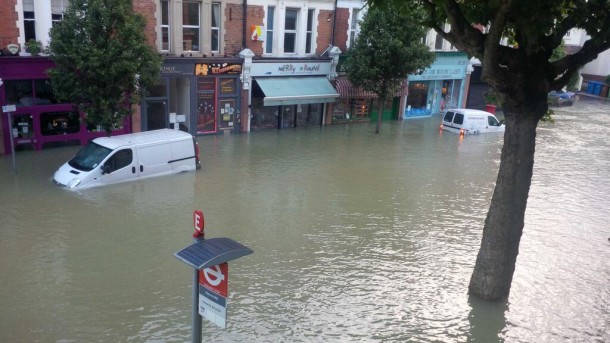Brixton Blog contributor Aimee Treasure is worried about Brixton’s sewage pipes and frequent flooding, and here writes about her own recent such experience.

As the election looms, the main parties are trying to tackle the housing crisis by promising to build more homes. However, there’s one very unpleasant side effect of this that no seems to talk about: sewage.
London’s sewage may be an un-sexy subject, but is of paramount importance, and one of which I have very recent experience. In November 2014, the cellar of my house suddenly started flooding.
Despite the sewage level rising to more than a foot and posing a serious health risk, and making countless phone calls and emails, it took more than three weeks before anything was done. In the end, as a last resort, I publicly called the water company and local council out on social media. They suddenly jumped to attention.
Outsourced teams from a major drainage company had to pump out the sewage every morning and every evening, with the sewage returning to a foot in depth every 12 hours. My partner, our cat and I were confined to a single room for weeks; a refuge from the appalling odour and potential health risk. Due to the cat, we were unable to take up the water company’s offer of B&B accommodation.
The collapse was so deep (forty feet) that a major engineering solution was required to solve it. The road was dug up over Christmas, so that workers could clamber deep down underground to fix the pipe. While this was going on, the road effectively became an open sewer. At least the teams from the outsourced drainage company were pleasant, efficient and worked around our long and anti-social working hours.

The after-effects of the flooding were devastating. The entire contents of my cellar were rendered fit only for destruction; the mammoth cleaning equipment which was dragged through my house every day damaged the woodwork, paintwork and carpets throughout the downstairs interior; and the exterior of my house was covered in dirt and dust as the deep excavation continued – ruining the outside paintwork. The whole experience also impacted my partner’s health – the dust and dirt worsened her respiratory illness.
The water company in question have refused to accept any responsibility, citing the drain as ‘adopted’ and have only paid the grand compensation of £150.00 ‘per flooding event’ which does not, somehow, relate to each time the cellar was re-flooded but to two events when the pump outs were staggered.
Since this, the cellars of three other houses in my road have started flooding with sewage. These residents received a swifter response due to my previous experience, but the saga is still ongoing after a month of sewage; we all still await the digging of a new manhole.
Our road is not the only location affected: Kennington Road has been forever overflowing with water at the same time as major construction work has taken place, and a burst sewage pipe was previously confirmed on Clapham Road in February 2014. Last summer a burst water main at Herne Hill devastated numerous homes and businesses; Thames Water accepted responsibility for the meter-deep flood from an 88-year-old water pipe. The roads surrounding the Brixton Junction development seem to be permanently flooded. Coincidence? I think not.

Even those who are not directly flooded will reap the long-term effects. The more hardcore surfaces we put down to replace absorbent surfaces (like grass), the more problems we make for ourselves. This is not just the building of houses on former green spaces, like parks, or rolling tarmac over grass kerbs, but the infill building of estates that are already crammed to the brim, and the average house-owner concreting, tarmacking and decking over their own gardens.
The disastrous combination of an increasing population, fewer green spaces and old drains means over-worked old drains and sewers that can’t cope. How long will it be before someone notices this problem, and more to the point, actually addresses it?




I thought this is only experienced in Africa…
Blimey, this has been top news on this blog for nearly a week. Important as it is since poor drainage blights residents lives and homes is there nothing else happening in Lambeth? I thought at least afew election bits and bobs would get a mention? Nearly a whole week on effluent that is more than enough.
[…] The after-effects of the flooding were devastating… Read the whole story in the Brixton Blog. […]
In that case we should ensure that Lambeth planning officials make building new sewers a part of the solution when allowing new developments, rather than a cause to create new problems. Old sewers are a problem – no getting away from it – and this ‘regeneration’ on a more intensive scale merely magnifies this problem.
Be careful what you complain about… Broken drainage is one of the reasons that Lambeth council is using to justify ‘regeneration’, ie demolition of homes.
We to had problems in Leander Road and I had to badger Thames water for 10 months to get them to fix the problem that had caused our cellar to flood with foul water! I am seeing a theme here . . .
Sudbourne Road had similar problems, mainly toward Branksome Road Junction. New sewers were fitted about 2.5 years ago, took about 6 months to complete though.
a real worry – perhaps you could post the ‘useful’ names & telephone numbers of the water company etc.?
What road do you live on that is affected? I have also had issues – on Leander Road
We had problems on Elm Park so very close to Leander Road. Thames Water make billions to distribute amongst shareholders.